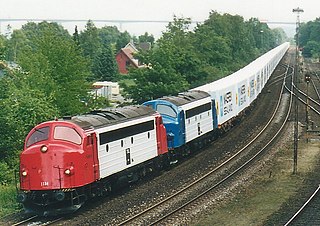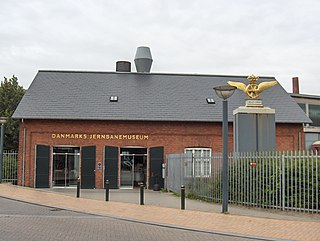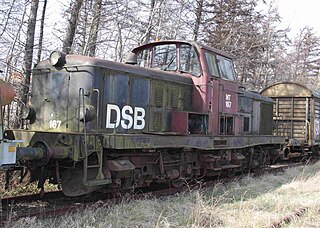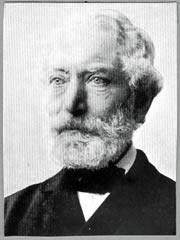
DSB, an abbreviation of Danske Statsbaner, is the largest Danish train operating company, and the largest in Scandinavia. While DSB is responsible for passenger train operation on most of the Danish railways, goods transport and railway maintenance are outside its scope. DSB runs a commuter rail system, called the S-train, in the area around the Danish capital, Copenhagen, that connects the different areas and suburbs in the greater metropolitan area. Between 2010 and 2017, DSB operated trains in Sweden.

The rail transport system in Denmark consists of 2,633 km of railway lines, of which the Copenhagen S-train network, the main line Helsingør-Copenhagen-Padborg, and the Lunderskov-Esbjerg line are electrified. Most traffic is passenger trains, although there is considerable transit goods traffic between Sweden and Germany.
NOHAB was a manufacturing company based in the city of Trollhättan, Sweden.

TraXion A/S was a Danish railway operating company that existed between 2001 and 2002. As an attempt to continue the activities of the bankrupt Privatbanen Sønderjylland (PBS/EuroRail), the company specialised in freight transport and operated on an independent commercial basis, as opposed to the approach of ownership of railway companies by the state or local authorities which is more prevalent in Denmark.

GM-Gruppen is a Norwegian heritage railway society that restored and operated Scandinavian diesel locomotives from General Motors Electro-Motive Division (GM-EMD). The organisation has restored one EMD G12, one DSB Class MY, one DSB Class MX and two NSB Di 3.

The Danish Railway Museum is the national railway museum of Denmark, located in the city of Odense. Established in 1975, it is situated in a former engine shed adjacent to the city's main railway station. It is the largest railway museum in Scandinavia.

The DSB class ME are a series of diesel-electric locomotives, introduced in 1981. Henschel built 37 for DSB. They were among the first AC drive locomotives in serial production. As of 2017, 33 units are still in service. The last was withdrawn in December 2021.

The class MY is a class of diesel-electric locomotives built in the years 1954–1965 by NOHAB. A total of 59 units, numbered 1101–1159, were delivered to the Danish State Railways. Powered by GM-EMD engines, the locomotives represented a significant change in rolling stock policy — motive power had largely been sourced from within Denmark for several decades.

The DSB Class EA was the first electric locomotive in Denmark, introduced in 1984. Twenty-two were built for DSB, about half were acquired by Deutsche Bahn in 2001 when it took over the freight business of DSB.

DSB class MZ was a series of 61 diesel-electric locomotives operated by Danske Statsbaner. They were built by NOHAB between 1967 and 1978 under licence from General Motors EMD with subcontractors Thrige-Titan and Frichs. There were four series of the locomotive built, designated I – IV.

The Danish State Railways (DSB) class D steam locomotive was a 2-6-0 freight steam locomotive developed in co-oporation between the DSB central engineering department and the German locomotive manufacturer Henschel. Class D with 100 units became the backbone of the DSB freight locomotives from the start of its delivery in 1902 until the start of the 1950s when the significance of the railway traffic started to decline. Together with the previous deliveries of the heavier 2-8-0 class H freight locomotive and then in 1952 purchased 10 Belgian-built German class 50ÜK locomotives, pushed the class D to the sidelines. When lightweight GM diesel locomotives class MX were delivered in the start of the 1960s, it was the swansong for class D. Only two class D engines, D 825 and D 826, were serviceable when DSB abandoned steam in 1970.

The F class was a type of steam locomotive used by Swedish State Railways and based on the Württemberg C. Eleven locos were built by Nydquist & Holm (NOHAB) between 1914 and 1916. It was primarily used on the main lines between Stockholm-Gothenburg and Stockholm-Malmö. It is one of the largest steam locomotives ever used in Sweden.

The class MT was a class of diesel-electric locomotives of the Danish State Railways (DSB). Built by Danish manufacturer Frichs, the locomotives entered service in 1958–1960. They were primarily used for heavy shunting and branch line trains. A total of 17 units were built, numbered 151–167.

The class MH was a class of diesel-hydraulic locomotives of the Danish State Railways (DSB), built by Danish manufacturer Frichs. A total of 120 units, numbered 301–420, were delivered between 1960 and 1965. They were primarily used for shunting and light freight traffic.

The DH 440 is a type of diesel-hydraulic locomotive built by Henschel in 1956–58 as one of their second-generation diesel locomotive types. They had wheel arrangement C, with three axles powered through a jackshaft.

DSB MY 1201 and 1202 were two diesel locomotives built by Frichs in Aarhus, Denmark in 1957 and 1960.

The Aarhus Central Workshops is a complex of listed buildings in Aarhus, Denmark and is the former DSB central train repair facility for Jutland and Fuenen. The buildings were completed in 1862 and was listed by the Danish Heritage Agency in the Danish national registry of protected buildings and places on 11 November 2005. The complex includes the central workshop building and the smithy (Smedjen). The building complex is situated in the central Indre By neighborhood close to the Aarhus Central Station.

Søren Frich was a Danish engineer, factory owner and city Councillor who built the Frichs company, with headquarters and main production in Aarhus. He became one of the largest employers in Aarhus and the Frichs factory became one of the only locomotive producers in Denmark. Frich was elected to the Aarhus city council three times.

Aarhus Flydedok was a company and floating dry dock in Aarhus, Denmark. The company was established in 1945 based on installations left by occupying German forces. From the mid to late 20th century it became one of the largest employers in the city and employed some 900 workers at its height. Aarhus Flydedok both produced and repaired ships although in its later years production focused on smaller vessels. The company entered bankruptcy proceedings in 1999 and finally closed in 2003.



















